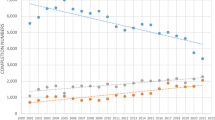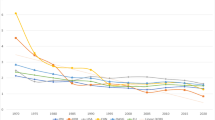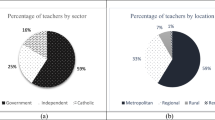Abstract
An investigation into the declining supply of principals in two states in Australia revealed that a mosaic of issues surrounds the overall trend towards fewer applications for vacant positions. Looking beyond systemic factors influencing this trend — factors such as the increasing workload of principals — this study discovered why some schools are more affected by a shortage of applicants than others. We found that one of four categories of deterrents was generally involved with declining numbers of applications: location, the size of school, the presence of an incumbent, or difficulties arising from local educational politics. We found, furthermore, that smaller numbers of applicants for vacant positions do not necessarily indicate a decline in interest in school leadership: interest in the principalship remains relatively high but principal aspirants have become increasingly strategic in their applications. Whilst drawing attention, in this paper, to the research finding that numerical interpretations of principal supply have serious limitations, we are keen to acknowledge, briefly, the research data that refers to (a) social and generational changes (b) demographic information, (c) teacher resistance to the modern principalship and how these data explain declining numbers. We also include information about recent changes that go counter to the trend.
Similar content being viewed by others
References
Achinstein, B. (2002)Community, Diversity and Conflict among School Teachers: The Ties that Blind, Teachers College Press, New York.
Australian Education Union (2003)New Teachers Survey, AEU, Victorian Branch, Melbourne.
Beaudin, B., J. Thompson & L. Jacobson (2002) The administrator paradox: more certified, fewer apply. Paper presented at the American Educational Research Association Annual Meeting, New Orleans, April.
Bell, E. (2001) “Schools’ principal shortage: fewer teachers want the job’s growing Challenges”, SFGate.com, Retrieved: 6 May 2002 http://www.sfgate.com/cgibin/article.cgi?f=/chronicle/archive/2001/09/23/MN170314.DTL.
Blackmore, J., C. Bigum, J. Hodgens & L. Laskey (1996) Managed change and selfmanagement in schools of the future,Leading and Managing, vol. 2, no. 3, pp. 195–220.
Blackmore, J., P. Thomson and K. Barty (in press) Principal selection: homosociability, the search for security and the production of normalised principal identities,Educational Management Administration and Leadership.
Bodger, S. (2000) “Principals struggling with ‘unmanageable’ workloads”, The New Zealand Herald Sun, Retrieved: 30 April 2002 http://www.nzherald.co.nz/storydisplay.cfm?thesection=&storyID=152669.
Bond, C. (2002) “A principal shortage looming?”, Achieveonline.com.au, Retrieved: 19 August 2003 www.achieveonline.com.au/article/articleview/278/1/1.
Boston Consultancy Group (2003)Schools Workforce Development Strategy, Department of Education and Training, Victoria, Melbourne.
Bowser, B. (2001) “Principal shortage”, Online NewsHour, Retrieved: 30 April 2002 http://www.pbs.org/ewshour/bb/education/jan-june01/principal_05-22.html.
Carlin, P., T. d’Arbon, J. Dorman & H. Neidhart (2003)Leadership Succession for Catholic schools in Victoria, South Australia and Tasmania, Final Report, Australian Catholic University, Strathfield.
d’Arbon, T. (2003) Future principals for the schools of the future. Paper presented to the National ACEL Conference, Thinking about Tomorrow, Darling Harbour, Sydney, September–October.
d’Arbon, T., P. Duignan & J. Duncan (2002a) Planning for future leadership of schools: an Australian study,Journal of Educational Administration, vol. 40, no. 5, pp. 468–485.
d’Arbon, T., H. Neidhart & P. Carlin (2002b) “Principal succession in Catholic primary and secondary schools in Victoria, South Australia and Tasmania: Opportunities and challenges”. Paper presented to the Australian Association of Research in Education Conference, Brisbane, December 1–4, Retrieved: 1 June 2003 http://www.aare.edu.au/02pap/car02106.htm.
d’Arbon, T., P. Duignan, J. Dwyer & K. Goodwin (2001)Leadership Succession in Catholic Schools in New South Wales: A Research Project on behalf of the Catholic Education Commission, New South Wales, Phase Two Final Report, Australian Catholic University, Strathfield.
d’Arbon, T. (2000) School principals for the new millennium. Paper presented to the Australian Association for Research in Education Conference, Sydney, December.
Department of Education and Training, Victoria (2003)Blueprint for Government Schools, DE&T, Melbourne.
Fenwick, L. & M. Pierce (2001) “The principal shortage: crisis or opportunity?” NAESP Principal Magazine, Retrieved: 30 April 2002 http://www.naesp.org/comm/p0301a.htm.
Gronn, P. (2003)The New Work of Educational Leaders: Changing Leadership Practice in an Era of School Reform, Paul Chapman Publishing, London.
Gronn, P. & F. Rawlings-Sanaei (2003) Principal recruitment in a climate of leadership disengagement,Australian Journal of Education, vol. 47, no. 2, pp. 172–85.
Hargreaves, A. (1994)Changing Teachers, Changing Times: Teachers’ Work and Culture in the Postmodern Age, Cassell, London.
Johnson, P. (2002) “Principal shortage emerges”, Great Falls Tribune Online, Retrieved: 2 May 2002 http://www.greatfallstribune.com/news/stories/20020331/localnews/38502.html.
Jones, B. (2001) The superintendent and principal shortage: points for policy, Policy Today, October, pp. 1–6.
Krüger, M. (1996) Gender issues in school headship. Quality versus power?European Journal of Education, vol. 31, no. 4, pp. 447–462.
Krüger, M., E. Van Eck & A. Vermeulen (2001) Why principals leave: premature departure of principals in primary and secondary education in the Netherlands. Paper presented at the American Educational Research Association Annual Meeting, Seattle, April.
Lacey, K. (2002a) Avoiding the principalship, Principal Matters, November, pp. 25–29.
Lacey, K. (2002b) “Understanding Principal Class Leadership Aspirations: Policy and Planning Implications”, Leadership Development Unit, Department of Education and Training Victoria, Retrieved: 1 July, 2002 http://www.sofweb.vic.edu.au/pd/schlead/pdf/understanding_prin_class_leadership _aspirations_report.pdf.
Lacey, K. (2003a)Executive Summary: Principal Class Aspirations Research Project, Department of Education and Training Victoria, Melbourne.
Lacey, K. (2003b) “Succession Planning in Education”, Retrieved: 17 June 2003 http://www.apapdc.edu.au.
MCEETYA (2003) “Demand and Supply of Primary and Secondary School Teachers in Australia”, Retrieved: 1 September 2003 http://www.mceetya.edu.au/public/demand.htm.
Mulford, B. (2003) School leaders: Changing roles and impact on teacher and school effectiveness. Paper commissioned by the Education and Training Policy Division, OECD for the activity “Attracting, developing and retaining effective teachers”, University of Tasmania.
Olson, L. (1999) “Demand for principals growing but candidates aren’t applying”,Education Week on the Web, March 3, 1999, Retrieved: 1 June 2002 http://www.edweek.org/ew/1999/25prin.h18.
Preston, B. (2002) Tracking trends in principal and teacher demand and supply. Paper presented to the Australian Association for Research in Education Conference, Brisbane, December.
Pritchard, A. (2003)Issues Concerning Succession Planning for the Principalship in Western Australian Catholic, State and Independent Schools, The University of Western Australia/APAPDC (WA branch).
Pugmire, T. (1999) “The principal shortage”,MPR Online, Retrieved: 1 May 2002 http://newsw.mpr.org/features/199908/30_pugmiret_safety/principal.shtml.
Rader, P. (2001) “O principals, where art thou?”The Link, Retrieved: 6 May 2002 http://www.education.umn.edu/alum/link/2001fall/principals.html.
Roza, M., M. Celio, J. Harvey & S. Wishon (2003) A Matter of Definition: Is There Truly a Shortage of School Principals? Centre on Reinventing Public Education, University of Washington.
Thomson, P. (2004) Severed heads and compliant bodies? A speculation about principal identities,Discourse, vol. 25, no. 1, pp. 43–59.
Thomson, P. (2002)Schooling the Rust Belt Kids. Making the Difference in Changing Times, Allen and Unwin, Lane Cove.
Thomson, P., J. Blackmore, J. Sachs & K. Tregenza (2002) High stakes principalship: sleepless nights, heart attacks and sudden death accountabilities. Reading representations of principal shortages in the USA,Australian Journal of Education, vol. 47, no. 2, pp 118–32.
Williams, T. (2001)Unrecognised Exodus, Unaccepted Accountability: The Looming Shortage of Principals and Vice-principals in Ontario Public School Boards. A Study for the Ontario Principals’ Council, Queen’s University, Ontario.
Author information
Authors and Affiliations
Rights and permissions
About this article
Cite this article
Barty, K., Thomson, P., Blackmore, J. et al. Unpacking the issues: Researching the shortage of school principals in two states in Australia. Aust. Educ. Res. 32, 1–18 (2005). https://doi.org/10.1007/BF03216824
Issue Date:
DOI: https://doi.org/10.1007/BF03216824




